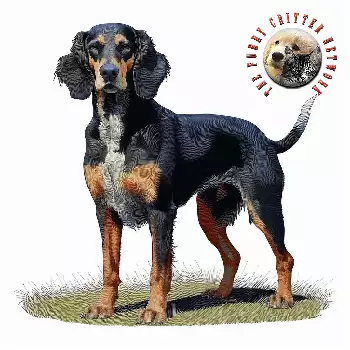The ancient history of the Erdelyi Kopo stretches back over a thousand years to the migration period of European history, when the Magyar tribes crossed the Carpathian Mountains into the Pannonian Basin in the 9th century. These nomadic peoples brought with them hunting dogs that would form the foundation stock for what would eventually become the Erdelyi Kopo, mixing with local hound breeds already present in the region to create a unique hunting companion perfectly adapted to the challenging terrain and abundant game of Transylvania.
During the medieval period, the breed gained prominence among Hungarian nobility who valued the dogs' exceptional abilities in hunting the diverse and often dangerous game that populated the vast forests of the Carpathian Mountains. Wild boar, brown bears, lynx, deer, and wolves all fell within the hunting range of these versatile hounds, requiring dogs of exceptional courage, stamina, and intelligence to successfully track and corner such formidable prey.
The geographic isolation and varied terrain of Transylvania played a crucial role in shaping the breed's development. The region's dense forests, steep mountain slopes, rocky outcroppings, and diverse microclimates created a natural testing ground that favored only the most adaptable and capable hunting dogs. Over centuries, this environmental pressure naturally selected for dogs with superior scenting ability, physical endurance, sure footing on difficult terrain, and the intelligence to work independently when separated from their human hunting partners.
Historical records indicate that originally two distinct varieties of the Erdelyi Kopo existed, differentiated primarily by size and intended hunting purpose. The larger variety, which is the sole survivor today, was bred specifically for hunting big game such as wild boar, bear, and deer in the extensive woodland areas of Transylvania. The smaller variety was developed for hunting smaller game like fox, hare, and chamois in more mountainous and rocky terrain where agility and compact size were advantageous over raw power and endurance.
The breed reached its historical peak during the Hungarian Kingdom's golden age, when elaborate hunting expeditions were common among the aristocracy and the maintenance of extensive hunting preserves required large packs of specialized hunting dogs. Royal and noble estates throughout Transylvania maintained breeding programs aimed at producing hounds capable of the most challenging hunting scenarios, leading to refinement of the breed's characteristics and establishment of consistent type.
The first official breed registration began in 1886 with the establishment of the "Hungarian Hunting Dog Pedigree" (Magyar Vadászeb Törzskönyv), marking the beginning of formal breed documentation and standardization. This early registration system helped preserve breeding records and establish the foundation for modern breed development, though political upheavals of the 20th century would severely impact these efforts.
The 20th century brought unprecedented challenges to the Erdelyi Kopo's survival. The collapse of the Austro-Hungarian Empire, two World Wars, and subsequent political reorganization of Eastern Europe created chaos that decimated breeding programs and scattered the breed's population. The situation became particularly dire after World War I when Transylvania was transferred from Hungary to Romania as part of the Treaty of Trianon, creating political and cultural tensions that affected breed preservation efforts.
World War II delivered an almost fatal blow to the breed's survival. The small variety disappeared entirely during this period, while the larger variety was reduced to critically low numbers. By 1947, when political changes in Romania led to active persecution of Hungarian cultural symbols, the breed faced potential extinction as Romanian authorities systematically eliminated remaining dogs to erase reminders of Transylvania's Hungarian heritage.
The breed's rescue from extinction began in 1941 when the Hungarian National Vizsla Club established a Hound Division specifically to preserve Hungarian hunting breeds. Initial recovery efforts began with just 27 individuals, but World War II interrupted these efforts before significant progress could be made. The serious reconstruction of the breed did not begin until the 1960s, when dedicated Hungarian breeders launched a systematic program to rebuild the population from the few surviving dogs scattered across Hungary and Slovakia.
The Fédération Cynologique Internationale granted official recognition to the Erdelyi Kopo in 1963, providing international validation that helped support conservation efforts and attract the attention of dog enthusiasts beyond Hungary. This recognition came at a crucial time when the breed's numbers remained critically low and every breeding decision carried enormous importance for the breed's genetic future.
The 1968 intensification of breed recovery efforts marked a turning point in the Erdelyi Kopo's modern history. Hungarian breeders, working with limited genetic material but unlimited dedication, carefully planned breeding programs aimed at rebuilding population numbers while maintaining the breed's essential characteristics and working ability. This period required extraordinary patience and expertise, as breeders had to balance the need for genetic diversity with the preservation of type and function.
International recognition continued with the United Kennel Club's acceptance of the breed in 2006, followed by entry into the American Kennel Club's Foundation Stock Service in 2015. These milestones represented significant progress in establishing the breed outside its native range, though numbers remain limited and the breed continues to require dedicated conservation efforts.
Today, the Erdelyi Kopo exists primarily in Hungary and Romania, with small populations in other European countries and very limited numbers in North America. The breed's modern story is one of careful preservation balanced with cautious expansion, as breeders work to ensure adequate genetic diversity while maintaining the authentic characteristics that make this ancient hunting breed unique. Modern conservation efforts focus not only on population numbers but also on preserving the breed's working abilities and the cultural heritage it represents.

